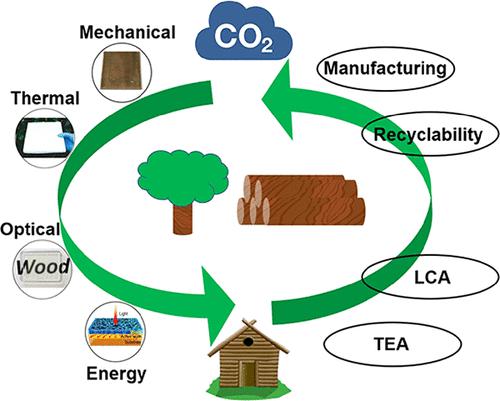当前位置:
X-MOL 学术
›
Chem. Rev.
›
论文详情
Our official English website, www.x-mol.net, welcomes your
feedback! (Note: you will need to create a separate account there.)
Emerging Engineered Wood for Building Applications
Chemical Reviews ( IF 51.4 ) Pub Date : 2022-10-19 , DOI: 10.1021/acs.chemrev.2c00450 Yu Ding 1 , Zhenqian Pang 2 , Kai Lan 3 , Yuan Yao 3 , Guido Panzarasa 4, 5 , Lin Xu 1 , Marco Lo Ricco 6 , Douglas R Rammer 6 , J Y Zhu 6 , Ming Hu 7 , Xuejun Pan 8 , Teng Li 2 , Ingo Burgert 4, 5 , Liangbing Hu 1, 9
Chemical Reviews ( IF 51.4 ) Pub Date : 2022-10-19 , DOI: 10.1021/acs.chemrev.2c00450 Yu Ding 1 , Zhenqian Pang 2 , Kai Lan 3 , Yuan Yao 3 , Guido Panzarasa 4, 5 , Lin Xu 1 , Marco Lo Ricco 6 , Douglas R Rammer 6 , J Y Zhu 6 , Ming Hu 7 , Xuejun Pan 8 , Teng Li 2 , Ingo Burgert 4, 5 , Liangbing Hu 1, 9
Affiliation

|
The building sector, including building operations and materials, was responsible for the emission of ∼11.9 gigatons of global energy-related CO2 in 2020, accounting for 37% of the total CO2 emissions, the largest share among different sectors. Lowering the carbon footprint of buildings requires the development of carbon-storage materials as well as novel designs that could enable multifunctional components to achieve widespread applications. Wood is one of the most abundant biomaterials on Earth and has been used for construction historically. Recent research breakthroughs on advanced engineered wood products epitomize this material’s tremendous yet largely untapped potential for addressing global sustainability challenges. In this review, we explore recent developments in chemically modified wood that will produce a new generation of engineered wood products for building applications. Traditionally, engineered wood products have primarily had a structural purpose, but this review broadens the classification to encompass more aspects of building performance. We begin by providing multiscale design principles of wood products from a computational point of view, followed by discussion of the chemical modifications and structural engineering methods used to modify wood in terms of its mechanical, thermal, optical, and energy-related performance. Additionally, we explore life cycle assessment and techno-economic analysis tools for guiding future research toward environmentally friendly and economically feasible directions for engineered wood products. Finally, this review highlights the current challenges and perspectives on future directions in this research field. By leveraging these new wood-based technologies and analysis tools for the fabrication of carbon-storage materials, it is possible to design sustainable and carbon-negative buildings, which could have a significant impact on mitigating climate change.
中文翻译:

用于建筑应用的新兴工程木材
2020 年,建筑行业(包括建筑运营和材料)排放了约 11.9 吉吨的全球能源相关 CO 2 ,占 CO 2总量的 37%排放量,在不同行业中所占份额最大。降低建筑物的碳足迹需要开发储碳材料以及能够使多功能组件实现广泛应用的新颖设计。木材是地球上最丰富的生物材料之一,历史上一直用于建筑。最近在高级工程木制品方面的研究突破体现了这种材料在应对全球可持续发展挑战方面巨大但尚未开发的潜力。在这篇综述中,我们探讨了化学改性木材的最新发展,这些发展将生产用于建筑应用的新一代工程木制品。传统上,工程木制品主要有结构用途,但这次审查扩大了分类范围,以涵盖建筑性能的更多方面。我们首先从计算的角度提供木制品的多尺度设计原则,然后讨论用于在机械、热学、光学和能源相关性能方面对木材进行改性的化学改性和结构工程方法。此外,我们探索生命周期评估和技术经济分析工具,以指导未来的工程木制品研究朝着环保和经济可行的方向发展。最后,这篇综述强调了该研究领域当前面临的挑战和对未来方向的展望。通过利用这些新的基于木材的技术和分析工具来制造碳储存材料,
更新日期:2022-10-19
中文翻译:

用于建筑应用的新兴工程木材
2020 年,建筑行业(包括建筑运营和材料)排放了约 11.9 吉吨的全球能源相关 CO 2 ,占 CO 2总量的 37%排放量,在不同行业中所占份额最大。降低建筑物的碳足迹需要开发储碳材料以及能够使多功能组件实现广泛应用的新颖设计。木材是地球上最丰富的生物材料之一,历史上一直用于建筑。最近在高级工程木制品方面的研究突破体现了这种材料在应对全球可持续发展挑战方面巨大但尚未开发的潜力。在这篇综述中,我们探讨了化学改性木材的最新发展,这些发展将生产用于建筑应用的新一代工程木制品。传统上,工程木制品主要有结构用途,但这次审查扩大了分类范围,以涵盖建筑性能的更多方面。我们首先从计算的角度提供木制品的多尺度设计原则,然后讨论用于在机械、热学、光学和能源相关性能方面对木材进行改性的化学改性和结构工程方法。此外,我们探索生命周期评估和技术经济分析工具,以指导未来的工程木制品研究朝着环保和经济可行的方向发展。最后,这篇综述强调了该研究领域当前面临的挑战和对未来方向的展望。通过利用这些新的基于木材的技术和分析工具来制造碳储存材料,













































 京公网安备 11010802027423号
京公网安备 11010802027423号